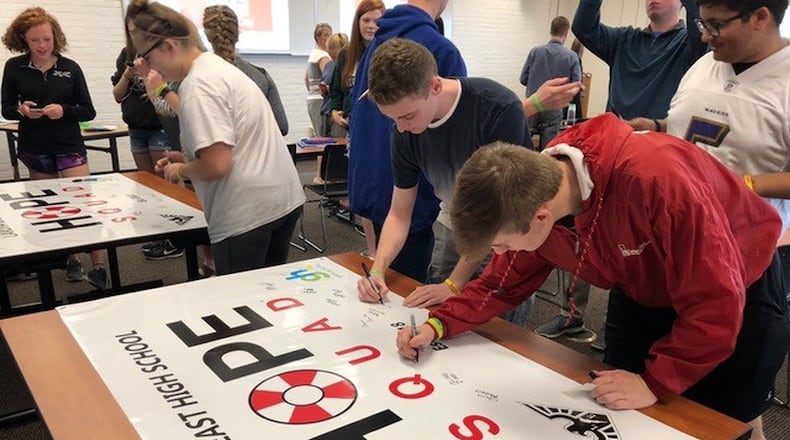“It’s a sad thing,” he said. “Every life has value, and when you lose a kid, it’s such a horrible waste.”
MORE: How to recognize Veterans Day in Butler County this year
Kline retired last year and now serves as executive director of Grant Us Hope, a non-profit focused on teen suicide prevention and mental wellness. Hope Squad is a school-based, peer-to-peer suicide prevention program that equips and empowers students to watch for warning signs and provide support to their peers who may be in emotional distress by referring them to trained adults, Kline said.
On Tuesday, more than 500 students throughout Butler and Warren counties and the region and 100 school advisers gathered for the second Ohio Hope Squad Conference at Lakota East High School.
Kline said these types of educational seminars are important because of the recent jump in teen suicides. Youth suicide has reached at least an 18-year high in Ohio, with 128 deaths by suicide in youth ages 8 to 19 in 2018, according to Ohio Department of Health data.
Suicide deaths have increased 45 percent overall between 2007 and 2018. For under age 25, the suicide rate has increased by 53 percent during that time, according to the ODH.
Kline, 57, said young people face different social pressures today than when he was a teen in the 1970s. Back then, he said, when a student was bullied at school, they went home and the bullying stopped. But with social media, the bullying can be continuous, he said.
“Young people struggle growing up in this day and age,” Kline said.
Three students who attended the conference — Lakota East freshman Ladeel Muhareb and Middletown High juniors Vivienne Hall and Amaree Middleton — said they learned the importance of recognizing potential signs of suicide early and contacting a person of authority immediately.
Hall and Middleton said if a friend told them about desires to commit suicide, they would talk to that person and not leave them alone.
Hope Squad, in its second year in Ohio, is expanding its reach and implementing peer-to-peer suicide prevention programs in 100 Ohio and Indiana schools this year, an increase of 45 schools in addition to the 55 schools launched last year.
Preliminary trends indicate the majority of suicide concerns reported by Hope Squad schools were about students in the ninth and 10th grades. More than a third of those students had a history of trauma in their lives, defined as physical, sexual or mental abuse, bullying, domestic violence or neglect, Kline said.
This information reveals that educating and providing support to students in their early teen years before they enter high school is “imperative,” Kline said. The transition from middle school to high school is “one of the most challenging times a child will experience,” and it’s critical to surround them with “care and hope during this time.” he said.
“We know students talk to each other when they are struggling emotionally,” he said.
However, seven out of 10 times, they do not share what they know with an adult who can help, he said. It costs about $4,000 for Grant Us Hope to launch a Hope Squad in a school, he said.
Last month, the Ohio House of Representatives voted 85-7 in favor of a bill to address youth suicides and school safety with new mandates for training, instruction and planning.
School districts would be required to establish a threat-assessment team and contract with an anonymous reporting system that operates 24/7 to receive safety tips and report the tip data to state officials. The Ohio Department of Public Safety provides a tip-line service for free to all districts.
School districts would also be required to train employees and teach students in sixth through 12th grades social inclusion, violence prevention and how to identify the signs of depression, suicide and self-harm. Districts would be required to designate a student-led group at each school to focus on suicide awareness, violence prevention and social inclusion.
WARNING SIGNS OF SUICIDE
Talking about wanting to die
Looking for a way to kill oneself
Talking about feeling hopeless or having no purpose
Talking about feeling trapped or in unbearable pain
Talking about being a burden to others
Increasing the use of alcohol or drugs
Acting anxious, agitated or reckless
Sleeping too little or too much
Withdrawing or feeling isolated
Showing rage or talking about seeking revenge
Displaying extreme mood swings
The more of these signs a person shows, the greater the risk. Warning signs are associated with suicide but might not be what causes a suicide.
SOURCE: American Foundation for Suicide Prevention
WHAT TO DO
If someone you know exhibits warning signs of suicide:
Do not leave the person alone.
Remove any firearms, alcohol, drugs or sharp objects that could be used in a suicide attempt.
Call the U.S. National Suicide Prevention Lifeline at 800-273-TALK (8255).
Take the person to an emergency room or seek help from a medical or mental health professional.
About the Author

